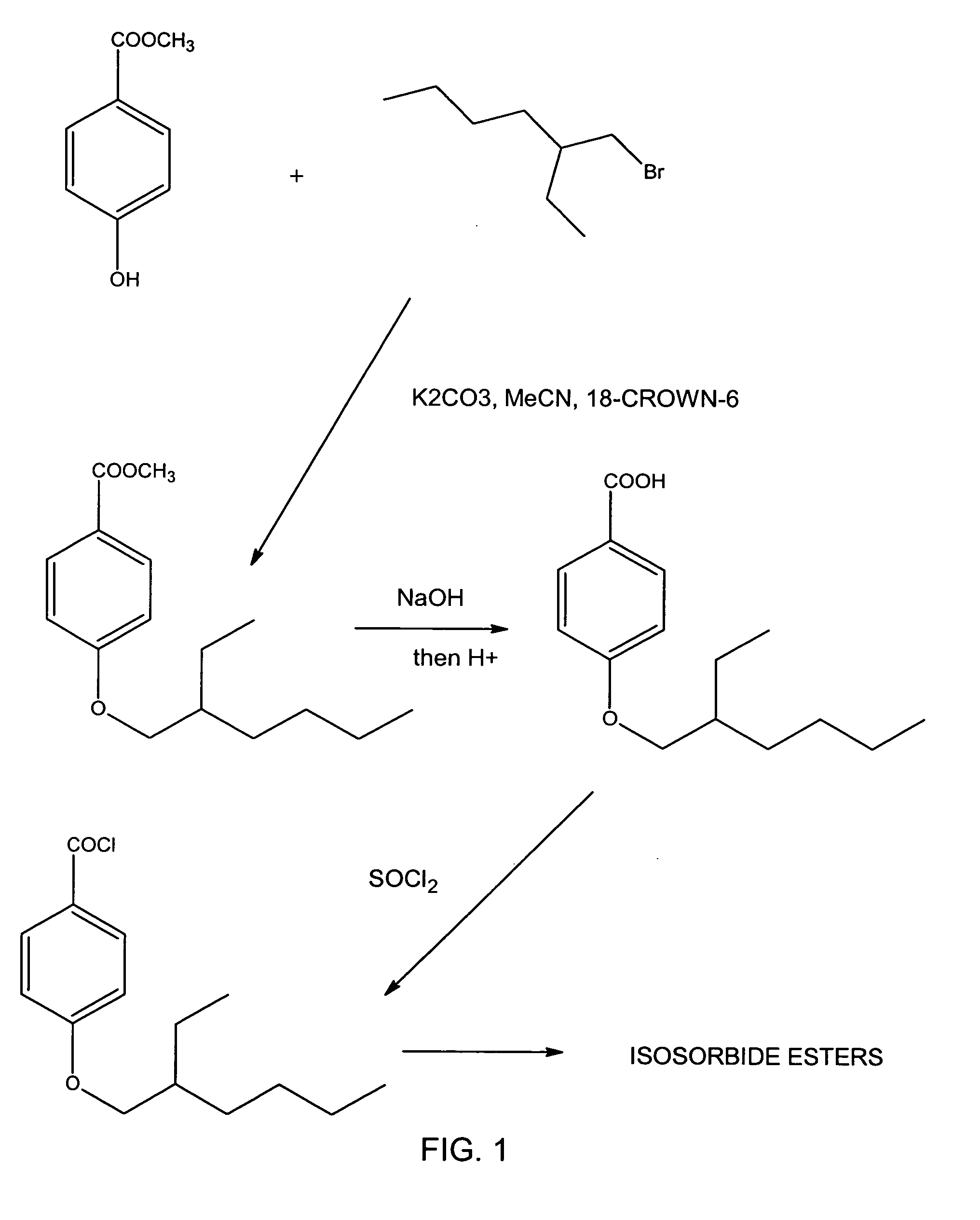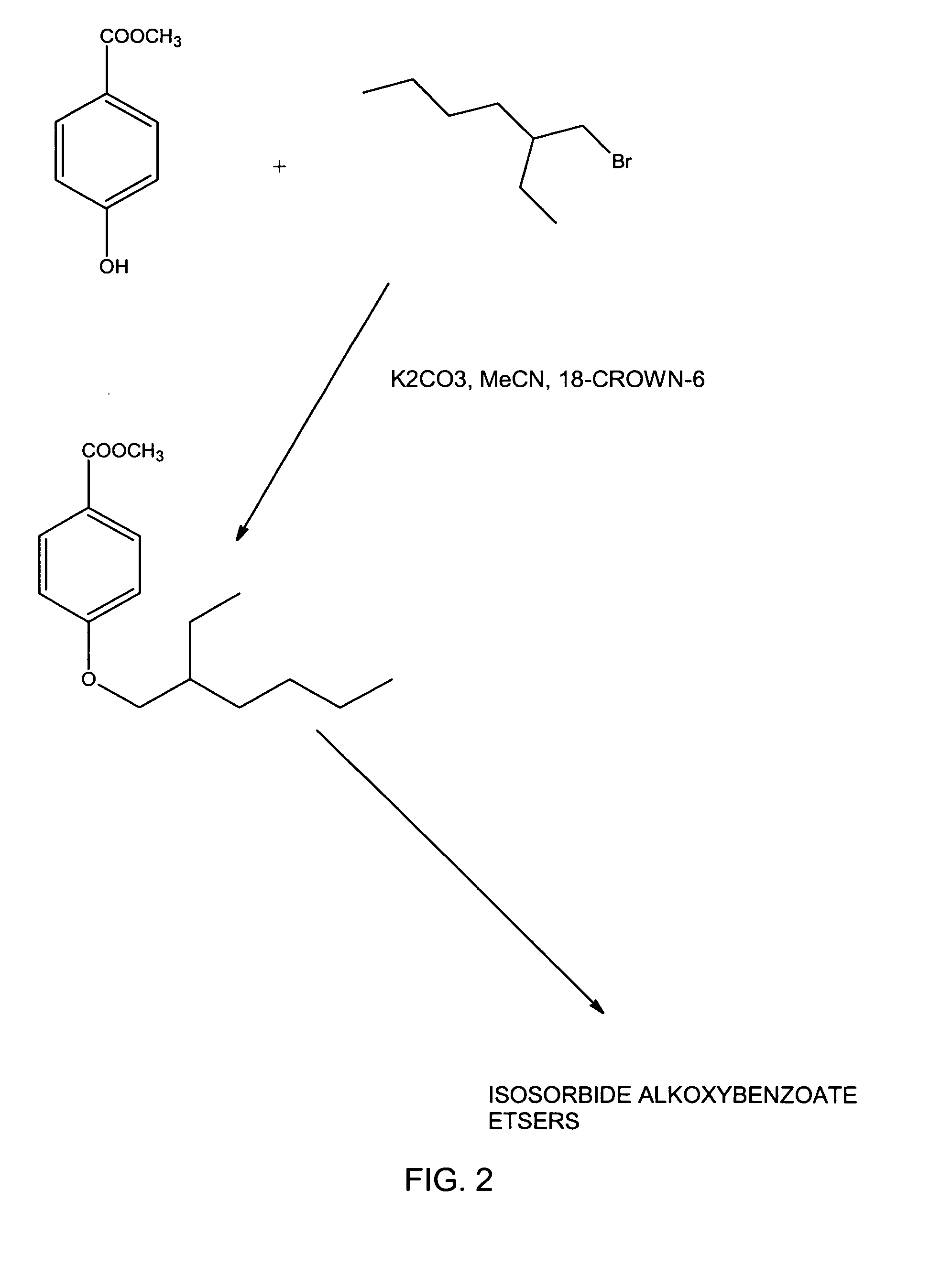Esters of anhydrosugar alcohols as plasticizers
anhydrosugar alcohol and esters technology, applied in the preparation of carboxylic acid esters, chemistry apparatus and processes, organic chemistry, etc., can solve the problems of phthalate plasticizers recently come under intense scrutiny and potential adverse health effects
- Summary
- Abstract
- Description
- Claims
- Application Information
AI Technical Summary
Problems solved by technology
Method used
Image
Examples
example 1
Isosorbide bis4-(2-Ethylhexyloxy)Benzoate
Preparation of Methyl4-(2-Ethylhexyloxy)Benzoate
[0016]A 1000 ml 4-necked flask was fitted with a reflux condenser, paddle stirrer and shaft seal, a pressure-equalizing tap funnel and argon gas inlet. A bubbler tube was fitted to the top of the condenser. The flask was charged with 68.4 g (0.45 moles) of methyl 4-hydroxy-benzoate, 1.0 g 18-crown-6 ether, 500 ml acetonitrile (HPLC grade) and 100 g, (0.72 moles) anhydrous potassium carbonate. The tap funnel was charged with 100 g, (0.52 mole) of 2-ethylhexyl bromide and the apparatus sparged with argon. A slow stream of argon was passed through the reaction mixture. The mixture was stirred briskly and gently refluxed while the alkyl bromide was added dropwise over 1-2 hours. Then the mixture was refluxed overnight for a total of about 20 hours and finally left to cool with stirring so that the solids did not cake in the flask. While still warm the slurry was poured into 2000 ml distilled water a...
example 2
Preparation of Isosorbide bis4-(2-Ethylhexyloxy)Benzoate Using the Acid Halide as Synthesized in Example 1
[0019]A 500 ml 4-neck flask was fitted with a paddle stirrer, pressure-equalizing dropping funnel and a long thermometer dipping into the liquid in the flask. The fourth neck was fitted with a short air condenser and a Drierite guard tube. All glassware was thoroughly dry. The flask was charged with 82 g (1.038 mole) of dry pyridine, 16.83 g (0.115 mole) anhydrous isosorbide, and the flask chilled in a bath of ice and salt to reduce the batch temperature to 0-5° C. A solution of 92.7 g (0.346 mole) acid chloride (prepared as above) in 100 ml dry dichloromethane was added dropwise from the tap funnel at such a rate as to keep the batch below 5° C. Gradually, the batch became cloudy and the flask filled with precipitated pyridine hydrochloride salt. When all the acid chloride had been added, the pasty mixture was left to stir overnight and warm up to room temperature. The next day...
example 3
Preparation of Isosorbide 2,5-bis[4-(2-Ethylhexyl)oxybenzoate]Ester by Direct Esterification
[0020]A mixture of 73 g (0.50 moles) of isosorbide, 270 g (1.08 moles) 4-(2-ethylhexyl)-oxybenzoic acid, 200 ml xylene and 1.0 g methanesulfonic acid is boiled briskly overnight under a slow nitrogen stream, under a Dean-Stark water separator until no more water collected in the Dean-Stark tube. The final yield of water is expected to be close to but less than 18.0 ml (100% theoretical). The xylene solution is shaken with three 80 ml portions of 10% sodium bicarbonate solution to remove unreacted acid and catalyst and then washed twice with 10% brine and finally with distilled water. The xylene layer is dried over anhydrous magnesium sulfate overnight, then filtered and the solvent evaporated to give a heavy brown oily liquid that is expected to yield between about 260 g and 320 g (85-95% theoretical).
PUM
| Property | Measurement | Unit |
|---|---|---|
| melting point | aaaaa | aaaaa |
| temperature | aaaaa | aaaaa |
| temperature | aaaaa | aaaaa |
Abstract
Description
Claims
Application Information
 Login to View More
Login to View More - R&D
- Intellectual Property
- Life Sciences
- Materials
- Tech Scout
- Unparalleled Data Quality
- Higher Quality Content
- 60% Fewer Hallucinations
Browse by: Latest US Patents, China's latest patents, Technical Efficacy Thesaurus, Application Domain, Technology Topic, Popular Technical Reports.
© 2025 PatSnap. All rights reserved.Legal|Privacy policy|Modern Slavery Act Transparency Statement|Sitemap|About US| Contact US: help@patsnap.com



